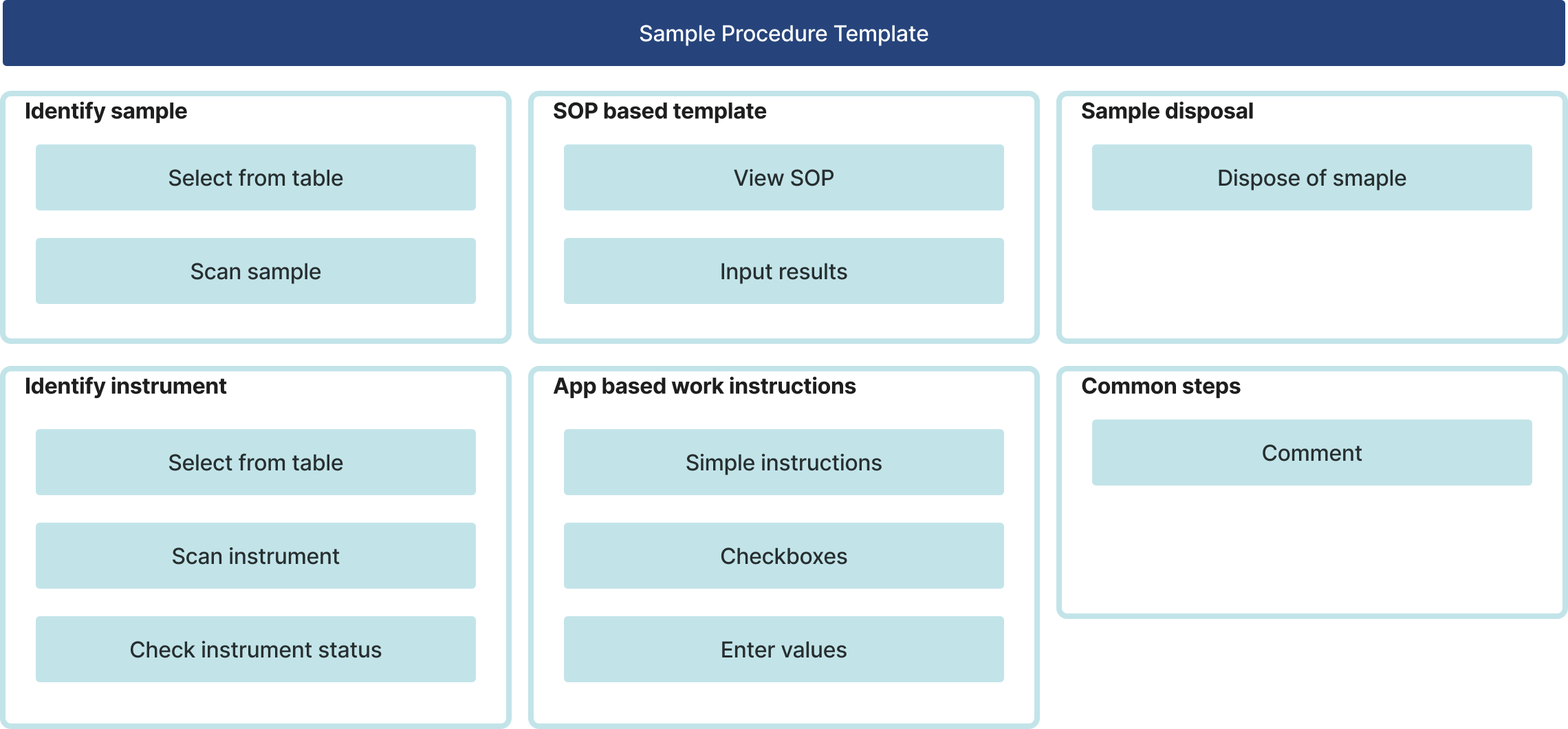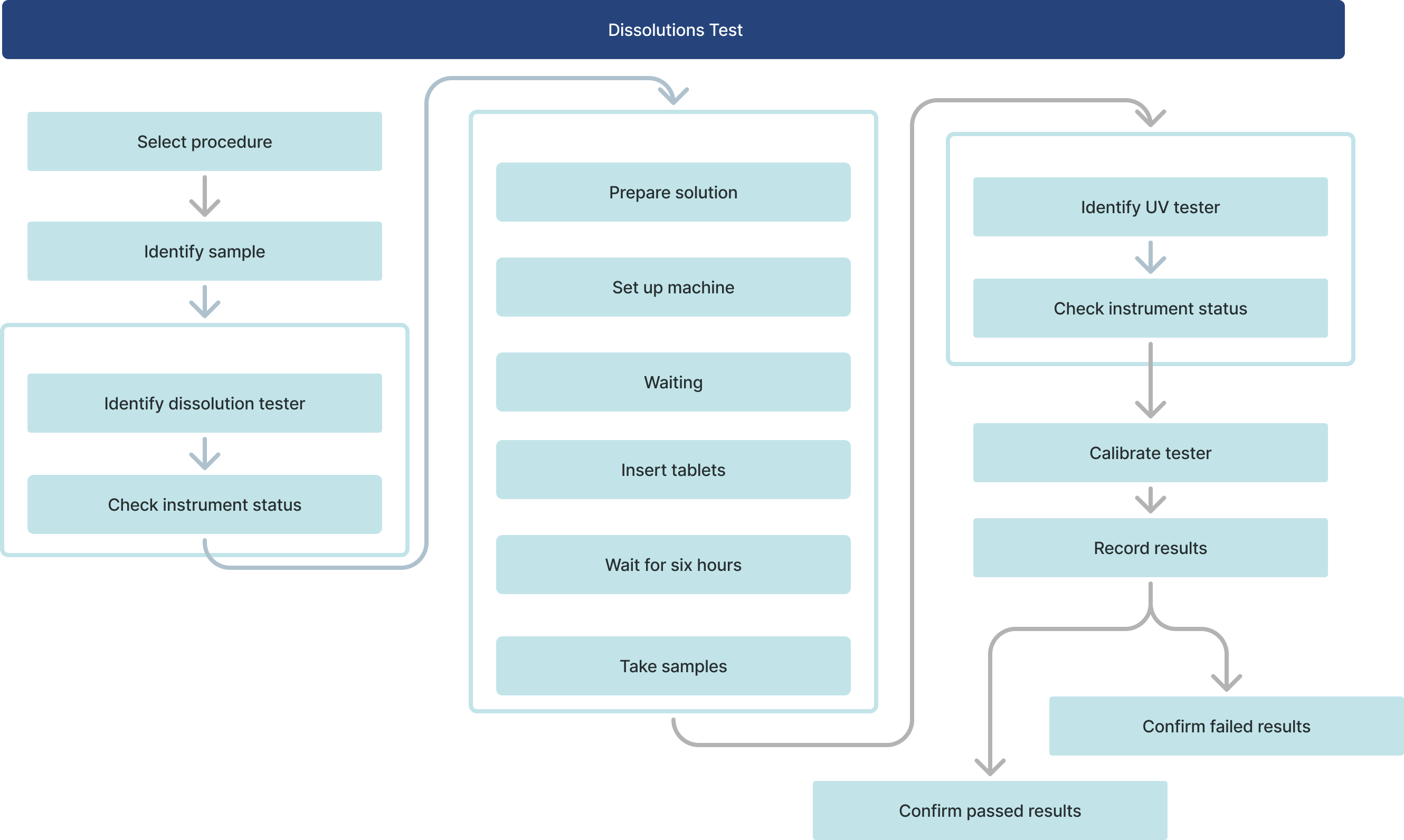The Sample Procedures app group within the Laboratory Operations app suite provides tools for managing sample-related workflows and navigating to specific sample procedures. It includes the Sampling Navigation Hub and Work Queues applications, enabling users to view pending samples and associated procedures.
Additionally, the app group offers a customizable Sample Procedure Template for building tailored workflows, covering steps such as sample and instrument identification, reviewing work instructions, completing procedures, and logging inspection results.
Three sample procedure examples are also included: pH Test, Dissolution Test, and Aliquoting. This app suite integrates seamlessly with the broader Laboratory Operations ecosystem, including the Instrument Management and Laboratory Management app suites.
Tables used in the app group
The Samples table stores all information about the location, quantity, and status of the samples. When a sample is received or taken, sample procedures are created in the Tasks table and linked to the corresponding sample. These tables are displayed in the navigation applications, allowing users to view pending samples and sample procedures and navigate to the appropriate procedure application.
If the Work Queue application is used for task selection, the context of the task is passed from the Work Queue app to a sample procedure using the Stations table (see details below in the Work Queue application description).
In the sample procedure applications (included in this app suite: Aliquoting, pH Test, and Dissolution Test), the sample procedure, sample, and instrument IDs are loaded at the beginning of the process from the Tasks, Samples, and Instruments tables, respectively. For sample procedures involving inspections, results are recorded and stored as entries in the Inspection Results table.
The Sample Procedures app group includes the following applications:
Sample Procedure Template

This is a template that does not mean to be run but serves as a set of template steps that can be copied and pasted into sample procedure applications. It consists of six step groups to simplify the searching process for the app builder.
The first two step groups provide options for the user to identify samples and inspections. Note that when there is a barcode scanner on the screen the triggers can be found on the step trigger list under Machines & devices. In the template there are two triggers the app builder can choose from: the first one is the ‘Scan and load’ trigger that can be used to load the sample or instrument when the artifacts are not loaded yet based on context. The second trigger, ‘Scan and compare’, needs to be used in scenarios where the sample or instrument is already loaded (for example in the Work Queue application) and passed to the sampling procedure via the Stations table.
The second two-step groups provide options for digital work instructions. The simple form of digital guidance is to display the SOP in a pdf format and then confirm that the procedure was done based on the pdf-based SOP. The second option is to replace the PDF instructions with the steps of the Tulip application. Here, each step refers to a physical action that the user needs to execute. The sequence of steps can be assembled from the steps in the ‘app-based work instructions’ step group. (Tipp: use multimedia to support your users in following instructions)
The last two steps are for disposing of the sample after the procedure and for logging comments during the execution of the procedure.
Add video on how to customize the template step to a pH Test app
Sampling navigation hub

The Sample Navigation Hub is the first option for navigating to procedures. It provides a straightforward solution where all sample procedures are listed on the main screen of the application. Navigation to the procedures does not require passing any context, as the pending task and its linked sample are selected directly within the procedure app. Additionally, users can view an overview of the sample list and procedure statuses.
Dissolution Test

The Dissolution Test is an example of a sample procedure composed of the steps of the Sample Procedure template.
Work Queue

The Work Queue application is the second option for navigating to sample procedures, offering a more advanced alternative to the simpler Sampling Navigation Hub. In this approach, the pending or in-progress task is selected from the Tasks table, and the Task ID is saved in the Stations table under the record of the current station. Once the Task ID is saved, the application navigates to the appropriate sample procedure for the selected task.
When the sample procedure application is launched, the Task ID is retrieved from the Stations table, and the corresponding Sample ID is fetched from the Tasks table. While this method is slightly more complex than the Sampling Navigation Hub, as it involves passing context between apps through a table, it provides seamless navigation between the main app and the sample procedure applications.
Aliquoting

Aliquoting is the process of dividing a bulk sample into multiple smaller test samples. This sample procedure can be initiated from the Work Queue application. Within the app, each aliquot is measured, and a label is printed for it individually.
Once all aliquots have been created, their barcodes are scanned, and the resulting samples are logged into the Sample Storage, along with the remaining bulk sample. The aliquoting task is then marked as DONE, and sample procedures for each aliquot (typically sample inspection tasks) are automatically created upon the creation of the aliquot samples.
pH Test

This application serves as another example of a straightforward sample procedure. It can be initiated from the Work Queue application, where digital work instructions guide the user through the pH testing process. Upon completing the pH test, the results are recorded and stored in the Inspection Results table.